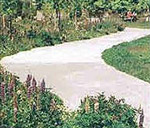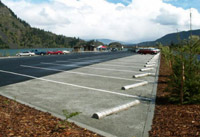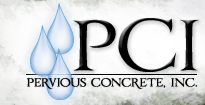- Home
- Contact Us
- Watch Video
- FAQ
- Benefits
- Qualifications
- Projects and Photos
- Articles & Press
- Resources
- Awards
Pervious Concrete, Inc.
Michael Bledsoe (President)
206-940-8900 (Mobile)
425-308-5555 (Office)
206-525-2800 (Fax)
mbledsoe@perviouscrete.com
Pervious Concrete, Inc.
P.O. Box 1579
Snohomish,
WA 98291-1579
Frequently Asked Questions
What is Pervious Concrete?
Traditionally reserved for greenhouses and erosion control, Pervious Concrete is a concrete pavement consisting of cement, coarse aggregates, water, and other specialty components to produce sufficient paste and bonding ability to glue coarse aggregates together. This creates an in-place void structure of approximately 14 to 18%. Essentially, Pervious Concrete is a structural concrete pavement that "drinks" water.

- Eliminates untreated storm water and creates zero runoff
- Directly recharges groundwater
- Mitigates first flush pollution
- Protects streams, watersheds, and ecosystems.
- Mimics the drainage and filtration of bioswales and natural soils
- Reduces surface temperatures & heat island effects
- Provides a higher albedo surface reflectivity index (0.35 or higher)
- Eliminates need for expensive collection and detention systems

Pervious Concrete may be used for: sidewalks, trails, residential driveways, residential streets, commercial parking areas or areas where storm water management is an issue. Generally, Pervious Concrete Pavement depths can range from 4 inches for sidewalks and trails, 5-6 inches for residential driveways and parking lots, and 8-10 inches for heavier truck traffic areas.
How are Retention/Recharge Layer and Subgrade Designed?Pervious Concrete is a 2 part on site storm water management system consisting of the concrete pavement and a coarse gravel retention layer for storm water storage. Design of the retention/recharge area is a site-specific task and should take into account, percability and characteristics of native soils, volume of storm water anticipated, rate of flow, and duration. An initial soils site survey, and site specific storm water calculations should be performed by a storm water management engineer.
What About Freeze-Thaw?
Pervious Concrete is not designed nor intended as a storage area. Water passes directly through the pavement and into the retention layer below. Freeze-Thaw is not a concern in western Washington as our temperatures and freeze-thaw conditions are nominal. However, pervious concrete has been placed in freeze-thaw climates for over 15 years. Successful applications of pervious concrete in freeze-thaw environments have two common design features - the cement paste is air-entrained, and the pervious concrete is placed on 6â??12 inches of drainable aggregate base (3/4" or larger clean gravel).
What About Clogging?
Clogging of any pervious surface can be a concern. It is highly unlikely a majority of any pervious surface will become 100% clogged. Water will always seek the next point of infiltration. Care should be taken to keep the surface free from silty or clay-like material, and to avoid clogging it with sand, topsoil, beauty bark and other debris. Chemical cleansers are not recommended; plan to use plain water to flush the pervious pavement voids, and to sweep or vacuum 1-2 times a year to remove soil and debris. Studies have been conducted that indicate pressure washing will restore the porosity of clogged pervious concrete to nearly new conditions.
What About Maintenance?Good common sense approaches to prevent placement of landscape materials and cleaning of any pervious surface are recommended practices. For parking areas, your regular parking lot sweeping/vacuuming program should be sufficient.
Our thanks to WashingtonConcrete.org and ConcreteParking.org for providing most of the information presented on this page.


